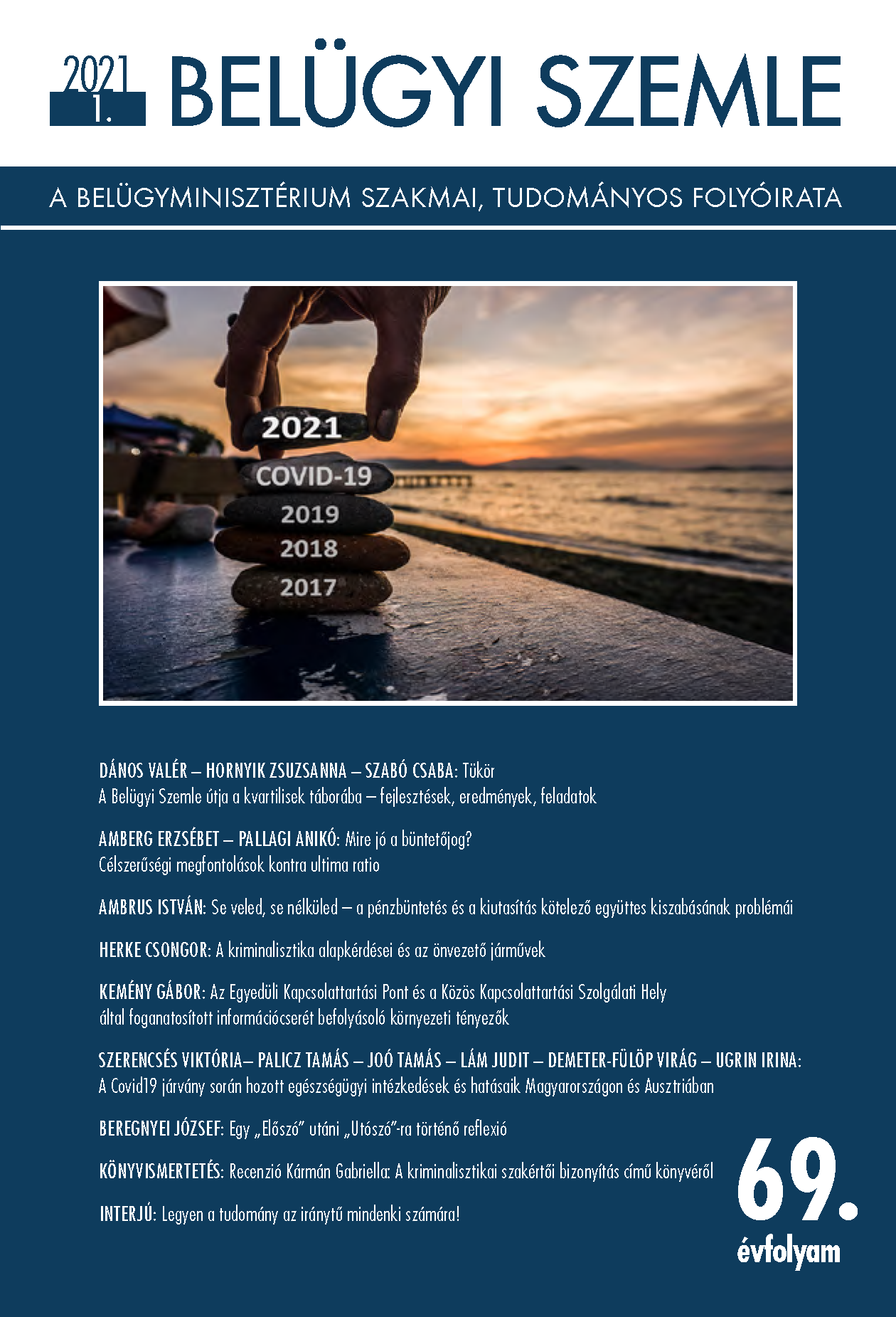Az Egyedüli Kapcsolattartási Pont és a Közös Kapcsolattartási Szolgálati Hely által foganatosított információcserét befolyásoló környezeti tényezők
Absztrakt
A határon átnyúló bűncselekmények, a növekvő hibrid biztonsági kockázat megköveteli a hatékony nemzetközi rendőri együttműködést és információcserét. Válaszként előbbi igényre számos csatorna jött létre és folytat napjainkban határon átnyúló információcserét. A két legismertebb az Egyedüli Kapcsolattartási Pont (SPOC), valamint a Közös Kapcsolattartási Szolgálati Hely (KSZH). Ezen kutatás célja, hogy betekintést nyújtson az olvasónak a határon átnyúló rendészeti információcsere világába, feltárja a folyamatot hátráltató, illetve támogató tényezőket, valamint a két csatorna működésében rejlő hasonlóságokat, különbségeket és lehetőségeket. A szerző ezt a célt a témában fellelhető releváns kutatások, valamint az általa végzett kvalitatív kutatás eredményeinek ismertetésével, valamint ajánlások megfogalmazásával kívánja elérni.
Érkezett: 2020. június 3.
Elfogadva: 2020. július 23.
Hivatkozások
Bayley, D. H. (1990): Patterns of Policing: A Comparative International Analysis. Rutgers University Press.
Bock, G.-W., Zmud, R. W., Kim, Y.-G. & Lee, J.-N. (2005): Behavioral Intention Formation in Knowledge Sharing: Examining the Roles of Extrinsic Motivators, Social-Psychological Factors, and Organizational Climate. MIS Quarterly, 29(1), 87–111. https://doi.org/10.2307/25148669
Bryman, A. (2012): Social research methods. Oxford University Press. https://doi.org/10.1017/CBO9781107415324.004
Bstieler, L. (2006): Trust formation in collaborative new product development. Journal of Product Innovation Management, 23(1), 56–72. https://doi.org/10.1111/j.1540-5885.2005.00181.x
Cater, B. (2008): The importance of social bonds for Communication and trust in marketing relationships in professional services. Management, 13(1), 1–15.
Chau, M., Zeng, D. D., Atabakhsh, H. & Chen, H. (2001): Building an Infrastructure for Law Enforcement Information Sharing and Collaboration: Design Issues and Challenges. Proceedings of The National Conference for Digital Government Research. Los Angeles, California, May 21–23.
Constant, D., Kiesler, S. & Sproull, L. (1994): What’s Mine Is Ours, or Is It? A Study of Attitudes about Information Sharing. Information Systems Research, 5(4), 400–421.
Doherty, R., Vandresse, B., Kamarás, É., Siede, A., Segerberg, J., Hert, P. & Mitsilegas, V. (2015): Study on the implementation of the European Information Exchange Model (EIXM) for strengthening law enforcement cooperation. Deloite, 108.
Európai Bizottság (2004): A Bizottság közleménye az Európai Parlamentnek és a tanácsnak az Európai Unión belüli rendőrségi és vámügyi együttműködés megerősítéséről I. Jelentés az amszterdami szerződés hatálybalépése óta elért eredményekről II. Fejlesztési javaslatok (COM/2004/0376).
Európai Bizottság (2012): A Bizottság Közleménye az Európai Parlamentnek, a Tanácsnak Az EU-n belüli bűnüldözési együttműködés erősítése: az európai információcsere-modell (COM/2012/0735 final).
Európai Unió (1985): Egyezmény a Benelux Gazdasági Unió államai, a Németországi Szövetségi Köztársaság és a Francia Köztársaság kormányai között a közös határaikon történő ellenőrzések fokozatos megszüntetéséről szóló, 1985. június 14-i Schengeni Megállapodás végrehajtásáról.
Európai Unió Tanácsa (2006): A Tanács 2006/960/IB Kerethatározata az Európai Unió tagállamainak bűnüldöző hatóságai közötti, információ és bűnüldözési operatív információcseréjének leegyszerűsítéséről (2006/960/JHA). Az Európai Unió Hivatalos Lapja.
Európai Unió Tanácsa (2018): Rendészeti Információcsere Útmutatója (6727/18).
Gil-García, J. R. & Pardo, T. A. (2005): E-government success factors: Mapping practical tools to theoretical foundations. Government Information Quarterly, 22(2), 187–216. https://doi.org/10.1016/j.giq.2005.02.001
Goldenberg, I. & Dean, W. H. (2017): Enablers and Barriers to Information sharing in Military and Security Operations: Lessons Learned. In Goldenberg, I., Soeters, J. & Dean, W. (eds.): Information sharing in military operations, 251–267. Springer
Hufnagel, S. (2016): Policing cooperation across borders. Routledge.
Kemény, G. (2019): Fifteen minutes to decide:The efficiency of cross-border information exchange conducted by the Single Point of Contact and the Police and Customs Cooperation Centre. Frontex
Keohane, R. O. (1986): Reciprocity in international relations. International Organization, 40(1), 1–27.
Kim, S. & Lee, H. (2006). The Impact of Organizational Context and Information Technology on Employee Knowledge-Sharing Capabilities. Public Administration Review, 66(3), 370–385. https://doi.org/10.1111/j.1540-6210.2006.00595.x
Kovács I. (2015): „Olajozás”, szervezett bűnözés és prostitúció a 90-es években Magyarországon. Nemzetbiztonsági Szemle, 3(1), 114–145.
Lane, C. & Bachmann, R. (1996): The Social Constitution of Trust: Supplier Relations in Britain and Germany. Organization Studies, 17(3), 365–395. https://doi.org/10.1177/017084069601700302
Mausolf, A. (2010): Keeping Up Appearances: Collaboration and Coordination in the Fight against Organized Crime and Terrorism. Unpublished Master’s Thesis, University of Leiden
Resteigne, D. & Bogaert, S. Van den. (2017): Information Sharing in Contemporary Operations: The Strength of SOF Ties. In Goldenberg, I., Soeters, J. & Dean, W. (eds.): Information sharing in military operations, 51–66. Springer https://doi.org/10.1007/978-3-319-42819-2_4
Saloven, M., Grant, E., Hanel, P., Makai, V., Brent Hansen, K., Belevicius, L. & Pohnitzer, A. (2010): Study on the status of information exchange amongst law enforcement authorities in the context of existing EU instruments. https://ec.europa.eu/home-affairs/sites/homeaffairs/files/doc_centre/police/docs/icmpd_study_lea_infoex.pdf
Saunders, M., Lewis, P. & Thornhill, A. (2008): Research Methods for Business Students. Pearson Education Limited.
Styczyńska, I. & Beaumont, E.-Z. (2017): Easing legal and administrative obstacles in EU border regions. Luxembourg: Publication Office of the European Union. https://doi.org/10.2776/251376
Wheatley, M. J. (2006): Leadership and the New Science: Discovering Order in a Chaotic World. Berrett-Koehler Publishers
Willem, A. & Buelens, M. (2007): Knowledge sharing in public sector organizations: The effect of organizational characteristics on interdepartmental knowledge sharing. Journal of Public Administration Research and Theory, 17(4), 581–606.
Yang, T.-M. & Maxwell, T. A. (2011): Information-sharing in public organizations: A literature review of interpersonal, intra-organizational and inter-organizational success factors. Government Information Quarterly, 28(2), 164–175. https://doi.org/10.1016/j.giq.2010.06.008
Yin, R. K. (2014): Case Study Research Design and Methods (5th ed.). Thousand Oaks, Sage.
Zhang, J. & Dawes, S. S. (2006): Expectations and Perceptions of Benefits, Barriers, and Success in Public Sector Knowledge Networks. Public Performance és Management Review, 29(4), 433–466.
Zhang, J., Sharon, S. D. & Sarkis, J. (2005): Exploring stakeholders’ expectations of the benefits and barriers of e‐government knowledge sharing. Journal of Enterprise Information Management, 18(5), 548–567. https://doi.org/10.1108/17410390510624007



















.png)

